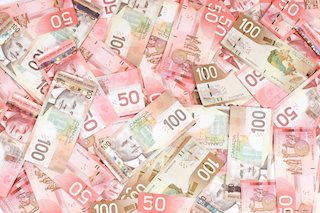USD/CAD sticks to modest gains above 1.3800 mark, lacks bullish conviction
|
- USD/CAD regains positive traction amid the emergence of some USD dip-buying.
- The Fed’s dovish stance drags the US bond yields lower and should cap the USD.
- A positive risk tone and the overnight rally in Oil prices warrant caution for bulls.
The USD/CAD pair attracts some dip-buyers on Thursday and moves away from a one-week trough, around the 1.3785 region touched the previous day. Spot prices currently trade around the 1.3815-1.3820 zone and seem to draw support from a goodish pickup in the US Dollar (USD) demand.
The USD Index (DXY), which tracks the Greenback against a basket of currencies, rebounds from the vicinity of a three-week low touched in the aftermath of the FOMC policy decision on Wednesday. The upside for the USD, however, seems limited in the wake of the Federal Reserve's (Fed) dovish outlook, signaling the likelihood of an early rate cut if inflation stays in line with expectations.
In fact, the US central bank acknowledged the recent progress on inflation and cooling in the labor market, opening the door for an imminent start of the rate-cutting cycle in September. This, in turn, drags the US Treasury bond yields to a multi-month low, which, along with a generally positive risk tone should cap gains for the safe-haven buck and act as a headwind for the USD/CAD pair.
Meanwhile, Crude Oil prices consolidate the previous day's strong gains amid the risk of a further escalation of tensions in the Middle East, which continues to fuel worries about supply disruptions from the key Oil producing region. This, in turn, could underpin the commodity-linked Loonie and contribute to capping the upside for the USD/CAD pair, warranting some caution for bullish traders.
There isn't any relevant market-moving economic data due for release on Thursday, either from the US or Canada, leaving spot prices at the mercy of the USD and Oil price dynamics. The focus, meanwhile, remains glued to the closely-watched US monthly employment details, popularly known as the Nonfarm Payrolls (NFP) report, due on Friday.
Canadian Dollar FAQs
The key factors driving the Canadian Dollar (CAD) are the level of interest rates set by the Bank of Canada (BoC), the price of Oil, Canada’s largest export, the health of its economy, inflation and the Trade Balance, which is the difference between the value of Canada’s exports versus its imports. Other factors include market sentiment – whether investors are taking on more risky assets (risk-on) or seeking safe-havens (risk-off) – with risk-on being CAD-positive. As its largest trading partner, the health of the US economy is also a key factor influencing the Canadian Dollar.
The Bank of Canada (BoC) has a significant influence on the Canadian Dollar by setting the level of interest rates that banks can lend to one another. This influences the level of interest rates for everyone. The main goal of the BoC is to maintain inflation at 1-3% by adjusting interest rates up or down. Relatively higher interest rates tend to be positive for the CAD. The Bank of Canada can also use quantitative easing and tightening to influence credit conditions, with the former CAD-negative and the latter CAD-positive.
The price of Oil is a key factor impacting the value of the Canadian Dollar. Petroleum is Canada’s biggest export, so Oil price tends to have an immediate impact on the CAD value. Generally, if Oil price rises CAD also goes up, as aggregate demand for the currency increases. The opposite is the case if the price of Oil falls. Higher Oil prices also tend to result in a greater likelihood of a positive Trade Balance, which is also supportive of the CAD.
While inflation had always traditionally been thought of as a negative factor for a currency since it lowers the value of money, the opposite has actually been the case in modern times with the relaxation of cross-border capital controls. Higher inflation tends to lead central banks to put up interest rates which attracts more capital inflows from global investors seeking a lucrative place to keep their money. This increases demand for the local currency, which in Canada’s case is the Canadian Dollar.
Macroeconomic data releases gauge the health of the economy and can have an impact on the Canadian Dollar. Indicators such as GDP, Manufacturing and Services PMIs, employment, and consumer sentiment surveys can all influence the direction of the CAD. A strong economy is good for the Canadian Dollar. Not only does it attract more foreign investment but it may encourage the Bank of Canada to put up interest rates, leading to a stronger currency. If economic data is weak, however, the CAD is likely to fall.
Information on these pages contains forward-looking statements that involve risks and uncertainties. Markets and instruments profiled on this page are for informational purposes only and should not in any way come across as a recommendation to buy or sell in these assets. You should do your own thorough research before making any investment decisions. FXStreet does not in any way guarantee that this information is free from mistakes, errors, or material misstatements. It also does not guarantee that this information is of a timely nature. Investing in Open Markets involves a great deal of risk, including the loss of all or a portion of your investment, as well as emotional distress. All risks, losses and costs associated with investing, including total loss of principal, are your responsibility. The views and opinions expressed in this article are those of the authors and do not necessarily reflect the official policy or position of FXStreet nor its advertisers.